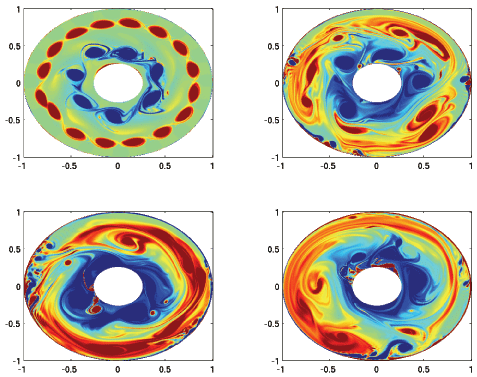
projects
fluids course
ISIM course
random old notes
hands-on school
Geophysical Turbulence
In geophysical flows it is often observed that large coherent vortices remain stable despite the existence of a strong turbulent environment; Jupiter's Great Red Spot is one of the most striking examples. While the nature of such stability and coherency is well accepted, what determines the typical size and strength of the coherent vortices is still largely unknown. This lack of understanding impacts much of our basic understanding of the dynamics of our own atmospheres and oceans. This project aims to use large scale numerical simulations to test a specific set of theories on the prediction of vortex size and strength in turbulent geophysical flows and the resulting turbulent statistics.Most large scale motions in atmospheres and oceans can be modeled as a two-dimensional flow in latitude and longitude coordinates. The relative dominance of the Coriolis force for large scale flows causes the flow to appear two-dimensional. Determination of the steady-state size and character of the resulting 2D vortices is thought to be prescribed by a delicate balance between forcing and dissipation in the entire geophysical system. The development of large, rotating vortices are shown in the images below from numerical simulations.

While the dominant vortices are two-dimensional, the forcing comes from three-dimensional motions; e.g. vertical convective motions in a lower atmospheric layer can drive a two-dimensional flow in an upper layer. Past rotating tank experiments have examined this transition from 2 to 3D flow and postulated mechanism for the formation of 2D coherent vortices in forced three-dimensional rotating flow. This explanation is inconsistent with the common 2D view of the balance between forcing and dissipation. My work aims to use large scale numerical experiments to resolve the inconsistencies in the current theories.
Collaborators: Harry Swinney, University of Texas at Austin and Sunny Jung NYU Courant Institute
Related publications
- Storey, B.D. 2004 Simulation of two-dimensional turbulent flows in a rotating annulus. International Journal for Numerical Methods in Fluids, 45, 231-252. (Full text)
- Jung, A., Storey, B.D., Aubert, J. & Swinney, H. 2004 Nonextensive statistical mechanics for a forced quasi-two-dimensional flow. Physica D, 193, 252-264. (Full text)